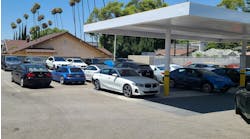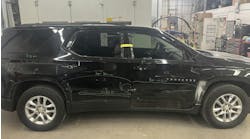Rod was the oldest body man in the shop. He spoke quietly and walked more slowly than all the other techs. He also made more money than they did. Many mornings he would be assigned a new job with structural damage. He would pull the vehicle in, remove a few pieces of damaged metal, bumper, headlights and the grille. Then he would sit down and start to peel his orange or cut up his apple. As it was usually not yet 9 a.m., most of the other techs thought Rod was taking a break a bit early. Some thought he was lazy. Rod would sit looking at the damaged car for a long time some mornings. Occasionally, he would walk over and take a measurement, then sit back down to his snack. After a while, he would start to work by placing his clamps and chains and pulling the damaged structure. In what seemed like no time, he was finished.
Rod didn't draw his plan out on paper, but he had a well thought-out plan before he began to make repairs. He examined the damage until he understood what it was and what it would take to put it back to the way it was before the accident. He knows that a certain amount of damage on the front of a frame rail of a given model would most likely travel back on the frame. He could then quickly confirm this by looking for what he expected to see under the car. Rod had the advantage of working on full frame vehicles when the state of the art was to pull frames until the sheet metal fit and the wheel alignment could be adjusted.Old Terminology
"Side sway," "sag," "mash," "diamond" and "twist" are all terms that have been used for decades to describe frame damage. Side sway once referred to frame rails moved or swayed to one side. It is also used to indicate any side movement of unibody structural members to one side of the centerline. Sag describes a full frame with the center section "sagged" as a result of a collision with the front or rear rails. Today this type of damage is unusual, yet the term is still used to refer to up or down movements. Mash and buckle simply means localized damage. Diamond and twist are intuitively obvious, yet not clearly understood. The structural members of a full frame or unibody can be seen roughly as a rectangle with the sides connected by cross braces and, in the case of unibody, a floor section. Collision damage can deform this rectangle into a diamond or twist it. Diamond or twist of a full frame structure is a relatively simple repair task. On a unibody, either of these conditions means the vehicle cannot be repaired. A good demonstration of this can be done with a piece of heavy-duty aluminum foil. Fold two edges to form "rocker panels," or tape two stir sticks to the edges. Hold the sides and move the "rocker panels" relative to each other. A twisted condition will clearly wrinkle the floor across most of its surface. Add a "cowl" to this model by folding one end of the foil up, and it too will be deformed. Repairing this much damage on a unibody car would be completely impractical. Moving one of the "rocker panels" forward of the other dramatically shows the diamond condition. The floor section will be severely deformed, illustrating another nearly impossible repair. Unibody structures with a twist or diamond may be considered structural total losses, because the condition of the structure, not just the cost of repairs, determines that they should not be repaired.Three Dimensional Analysis
To accomplish the degree of accuracy required to repair zero tolerance vehicles, careful three-dimensional measuring must be used during the repair process. The visual indications used to write the initial estimate are not sufficient to repair the vehicle's structure. An analysis of several identifiable points along a structure, all those control and reference points must be precisely made. Measurements will verify what part of the structure is not damaged and identify where the damage starts and ends. The damage near the point of impact is obvious, but how far into the structure the collision forces progressed needs to be determined. So-called hidden damage will not hide long from thorough measuring. The pulling process will address the damage nearest the center of the vehicle first.The process starts with the centerline of the vehicle. The center should always be checked first. On full-frame structures, this will be the first area repaired. On unibody vehicles, establishing that the center is undamaged is usually necessary before proceeding with repairs. Measuring points outward from center in both directions will locate all the structural damage to the vehicle. Measuring more points results in a more complete picture of the damage. On hard hits this becomes very important. Severe impacts can cause structures to move in less predictable ways than in the moderate hits observed more often by technicians. Taking six or eight measurements under the floor instead of the usual four will occasionally reveal a sag or tunnel twist. This is very unusual, but it could be missed. When using mechanical or electronic three-dimensional equipment, this process is relatively simple.
Upper Body, Too
Measuring the upper body of unibody structures or the body of full frame, or unibody-on-frame as some are calling it now, is the next step. The underside of the vehicle is very important when analyzing damage, but the top cannot be overlooked in a complete analysis. Direct damage from impact is the most obvious damage. This may travel into the upper body or may be mostly contained in the lower structural members. Indirect damage can easily be present in the upper body. The laws of physics dictate that energy will flow through the vehicle and parts in motion will try to continue to be in motion. So the body may flex and send waves through sheet metal parts such as quarter panels. The body may bend and require not only cosmetic repairs, but dimensional corrections as well. Accessing the upper body may require more complicated measuring processes. The temptation is to rely on how well the doors fit and other visual indicators. A thorough analysis will include some upper body measurements. Strut towers and upper rail measurements are particularly important with front damage as these dimensions affect suspension location.Coming Trends and Equipment
The equipment used will certainly affect how quickly this can be done. All that is absolutely necessary is a way to measure the height from the datum, the width from the centerline, and the length from one of the zero points. Liability concerns and increasing consumer awareness mean that recording before and after structural specifications will become more important in the future. This can be done manually in shops using mechanical measuring systems with sufficient accuracy. Many companies are now marketing electronic measuring systems as diagnostic tools. Precise printouts of structural damage, both before and after repairs, may become the standard operating procedure in the near future. As shops plan equipment purchases and establish standard operation procedures, this is one more item to consider.Accurate structural analysis is important for many reasons. Clearly documenting what is wrong-with accurate initial estimates or early supplements-streamlines the production cycle. Good records also minimize liability concerns. The technician who has a clear understanding of the damage to all three sections of the vehicle will produce consistent, high-quality repairs in less time.



